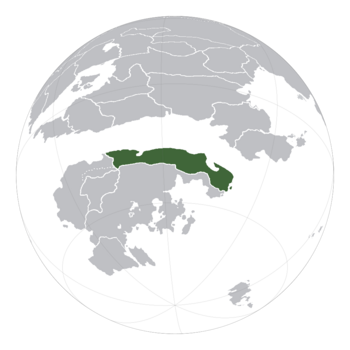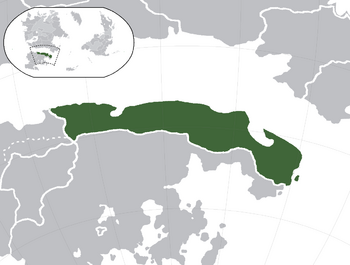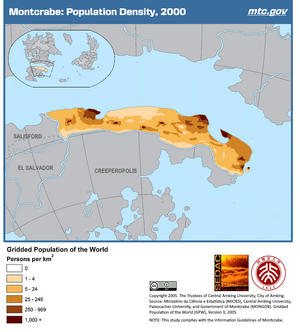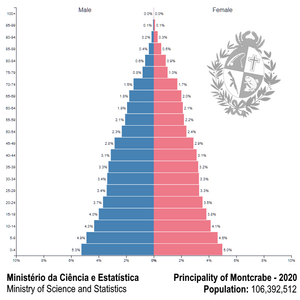Montcrabe
Romanyan Principality of Montcrabe Principado Romeno de Monscrabel (Gaúcho) | |
|---|---|
Motto: "Deus e Caranguejo fizeram montanha." (Gaúcho)
( God and Crab made a mountain. ) | |
Location of Montcrabe (dark green) | |
| Capital | Montcrabe City |
| Largest city | Perelocusta |
| Official languages | Gaúcho |
| Ethnic groups |
|
| Religion |
|
| Demonym(s) |
|
| Government | Absolute Monarchy |
| Zinedine Monscrabel | |
| Benjen Rothscrab | |
| Area | |
• Total | 953,368 sq mi (2,469,210 km2) (13th) |
• Water (%) | 2.8 |
| Population | |
• 2023 estimate | 106.3 million (7th) |
• Density | 111/sq mi (42.9/km2) |
| GDP (nominal) | 2022 estimate |
• Total | ᕮ 3.603 trillion crabinars (₵ 3.275 trillion Quebecshirite Credits) (8th) |
• Per capita | ᕮ 33,894 crabinars (₵ 29,674 Quebecshirite Credits) (15th) |
| Gini (2022) | very high |
| HDI (2022) | very high · 17th |
| Currency | Crabinar (ᕮ) |
| Time zone | AMT+4,+3, +2, +1 (AMT) |
| Date format | dd/mm/yyyy |
| Driving side | right |
| Calling code | +77 |
| Internet TLD | .mc |
Montcrabe, (Gaúcho: Monscrabel; Montcrabin Gaúcho: [mõskɾaˈbɛw] (![]() listen)) officially the Principality of Montcrabe (Gaúcho: Principado de Monscrabel), is a country located in the northern coast of Sur, and whose territory also includes the archipelago of Ilhavelha in the Romanyan Sea. Montcrabe shares a border to the south with the Holy Traditionalist Empire of Creeperopolis, and to the west with the Kingdom of Salisford and the Imperial Republic of El Salvador. Its capital city, and seat of the royal house, is Montcrabe City, and its most populous city is Perelocusta, with a residing population of over 11 million. Divided into 5 districts, 3 urban municipalities, and 1 autonomous district, which span a total of 2,469,213 km2 (953,368 sq mi), the Principality of Montcrabe has a population of around 106.3 million, making it the 7th most populous nation in the world. It is one of the most culturally diverse countries in the world, due to mass immigration from all over the world, and is the largest Gaúcho-speaking country by population.
listen)) officially the Principality of Montcrabe (Gaúcho: Principado de Monscrabel), is a country located in the northern coast of Sur, and whose territory also includes the archipelago of Ilhavelha in the Romanyan Sea. Montcrabe shares a border to the south with the Holy Traditionalist Empire of Creeperopolis, and to the west with the Kingdom of Salisford and the Imperial Republic of El Salvador. Its capital city, and seat of the royal house, is Montcrabe City, and its most populous city is Perelocusta, with a residing population of over 11 million. Divided into 5 districts, 3 urban municipalities, and 1 autonomous district, which span a total of 2,469,213 km2 (953,368 sq mi), the Principality of Montcrabe has a population of around 106.3 million, making it the 7th most populous nation in the world. It is one of the most culturally diverse countries in the world, due to mass immigration from all over the world, and is the largest Gaúcho-speaking country by population.
Montcrabe's first inhabitants embarked on a migration from Ecros across the Romanyan Sea approximately 25,000 years ago, arriving in the Surian region. While some continued their migration through the Bay of Salvador into what is now Creeperopolis, the dawn of sedentary civilizations in Montcrabe can be traced back to 7,000 BC, specifically in the central Calassa region, where cave paintings and artifacts such as stone tools and campfire remnants have been radiocarbon-dated to this era. Montcrabin cultures played a pivotal role in the domestication of maize, beans, and tomatoes, revolutionizing agriculture and enabling a smoother transition to settled life for previously nomadic hunter-gatherer communities. Over subsequent centuries, Montcrabe witnessed the development of early cultures, the emergence of religions, and advancements in technology encompassing new tools, weaponry, and numerical systems.
Montcrabe is a largely influential country, culturally and linguistically, due to various different emigration waves into different other countries and continents, with an estimated worldwide Crabin population of 120 million. It also has one of the youngest populations worldwide, with approximately 45 per cent of its 106 million population being under 25 years old. The country's economy is the 3rd largest in Sur, behind Salisford and Creeperopolis, the 8th largest in the world by nominal GDP, and holds one of the largest gold reserves in the world at its national bank. Montcrabe boasts a very high Human Development Index, ranking as the highest in Sur, and 17th worldwide, thanks to its high life expectancy, education, lack of personal income tax, and universal health care programs. Despite this, it is also one of the countries with the highest Gini coefficients, at a 72% in wealth inequality. In addition to being one of six founding members of the Cooperation and Development Coalition, Montcrabe is an active member of the Terraconserva Council of Nations, Treaty of Anti-Communism, Prosperity 7, and the Gaúcho Commonwealth.
Contents
- 1 Etymology and pronunciation
- 2 History
- 2.1 Prehistory (before 6th century BC)
- 2.2 Antiquity (6th century BC–1st century AD)
- 2.3 Romanyan Occupation (1st–7th century)
- 2.4 Principality of Montcrabe (7th–11th century)
- 2.5 Early Middle Ages (7th–11th century)
- 2.6 High Middle Ages (11th–15th century)
- 2.7 Montcrabin Renascimento & Empire (15th century–1779)
- 2.8 Principality's Commonwealth (1779–1824)
- 2.9 Constitutional Era (1824–1892)
- 2.10 Return to Principality (1892–1900)
- 2.11 Montcrabin Civil War (1900–1907)
- 2.12 Reconstruction and Consolidation (1907–1950)
- 2.13 Contemporary Period (1950–present)
- 3 Geography
- 4 Government and politics
- 5 Economy
- 6 Demographics
- 7 Culture
- 8 Notes
Etymology and pronunciation
The name of Montcrabe (Monscrabel) originated in 521 A.D. following its discovery by the Romanyan Empire. Officially named "Mounteicoste", translated to the "Coastal Mountain", many began calling the newly-founded coastal settlement "Crab's Mountain", due to the high crab and lobster populations of the coast. The name was not considered official until the arrival of Fausto Monscrabel (named Fausto Sesino prior to his leadership), who liked the name so much he decided to name both himself and the newly established country after it. Designated a Principality, unique in title, Montcrabe never changed its mainland title to that of a Kingdom or Empire. The Montcrabin Empire would later be used to refer to the entirety of Montcrabe's foreign colonial holdings (including Araucarlia and Reykanes), whereas the Principality of Montcrabe (O Principado de Monscrabel) solely stood for the Surian territory.
In Jackian, Montcrabe is pronounced /mntˈkræb/, or the Principality of Montcrabe as /ðə ˌprnsɪˈaeælɪti əv mntˈkræb/. In Montcrabin Gaúcho, Monscrabel is pronounced as /mõskɾaˈbɛw/, or Principado de Monscrabel as /pɾĩsiˈpadu dʒi mõskɾaˈbɛw/.
History
Prehistory (before 6th century BC)

Archeologists believe the first inhabitants of Montcrabe migrated from Ecros through the Romanyan Sea by means of boat, roughly 30,000 years ago. Despite some humans continuing their migration through the Bay of Salvador into modern-day Creeperopolis, the first sedentary civilizations in Montcrabe can be dated back to 7,000 BC, in the region of Calassa. Cave paintings, and early relics such as stone tools and campfire remains, were radiocarbon-dated to this same period. Montcrabe is the site of maize, bean, and tomato domestication, which provided a massive agricultural benefit to the first human settlements in the region, and allowed an easier transition into sedentarism for hunter-gatherers. Subsequent centuries saw the development of early cultures and religions, and the advancement of technology in the form of new tools, weapons, and even numeric systems.
It is believed by historians that, around 6,500 BC, infighting between tribes and settlements in Calassa led to a mass disapora into the surrounding Viseu and Abassia regions to the east. Despite the migration of various groups due to this, early villages and central communities continued to expand in both territory and population, and early signs of organized society began to be seen. Separating themselves into various tribes, leaders were often chosen by means of strength and prowess, and anointed by priests for their roles as figureheads.
The first complex civilization in Montcrabe was the Prudenta culture, which expanded most of north-eastern Calassia and the coast. Their strategic positioning allowed them to flourish as a trade hub for surrounding tribes and settlements, and spread their culture to nearby communities. Established as a major chiefdom around 3500 BC, the Prudentas grew in influence unperturbed for about a millenia, renowned as great artisans and scholars. Their creation of the first Surian writing system, and their use of metallurgy, established them as a majorly influential power in the region. This formative period saw the rapid development of agriculture and building, and the mass expansion of villages into large-scale cities and states.

In eastern Montcrabe's Abassia region, the later prehistoric period saw the rapid rise of the militaristic Homard Empire. Based out of Eitenenatl, with an estimated population of over 200,000, the Homards gained acclaim for their construction of massive pyramid structures as both ritual sites and operable buildings in their cities. Their early mastery of metallurgy allowed their violent expansion into surrounding territories, infamous for often capturing opposing chiefs and sacrificing them atop newly built pyramids for their Gods. At the height of the Old Homard Empire, in approximately 2500 BC, they stretched out through the entirety of the Abassia and Costea regions of Montcrabe, limited from expanding further by the Creeperian Range and the Prudentas themselves. Clashes between the two major civilizations brought with them unrest and violence throughout the territory, with the eventual collapse of the first Homard Empire in 2000 BC.
Contemporary records suggest a migratory wave into modern-day Ilhavelha, following the collapse of the Empire, by various Homard religious figures and aristocrats. The Homards gradually assimilated the island's native tribes into their own culture, forcing their own religious beliefs as the standard through a series of battles and skirmishes against local chiefs. The start of the New Homard Empire is traditionally dated to 1600 BC, after the consolidation of their newfound territories in Ilhavelha. A new capital was established in the island, and maritime expansions back into the Abassia region served to expand the territorial domains of the civilization. Despite the culture's association with violence and sacrifice, a political shift away from religious figureheads led the Empire into an era of remarkable internal development. Writings of scholars and poets made way for the Montcrabin mythology of the time, with the foundational mythological texts of the Origem, the Joritad, and the Vindicta by Tomasem being dated to this era.
Antiquity (6th century BC–1st century AD)
Text
Romanyan Occupation (1st–7th century)
Text
Principality of Montcrabe (7th–11th century)
Text
Early Middle Ages (7th–11th century)
Text
High Middle Ages (11th–15th century)
Text
Montcrabin Renascimento & Empire (15th century–1779)
Text
Principality's Commonwealth (1779–1824)
Text
Constitutional Era (1824–1892)
Text
Return to Principality (1892–1900)
Text
Montcrabin Civil War (1900–1907)
Text
Reconstruction and Consolidation (1907–1950)
Text
Contemporary Period (1950–present)
Text
Geography
Topography
Text
Biodiversity
Text
Climate
Text
Government and politics
Government
Text
Foreign relations
Text
Military
Text
Law enforcement and crime
Text
Political subdivisions
The boundaries and district limitations of Montcrabe began, originally in the form of counties and baronies, during the High Middle Ages. Natural limitations, charted by cartographers of the time, were adapted into official borders to distribute power down to smaller appointed district governments during the era of the Montcrabin Empire. Anchunha, Fregente, Calassa, Viseu, Cavaco (now known as Cantoño), and Abassia were the first official subdivisions recognized as territorial limitations of the Principality (despite later losing Cantoño to Atlántida). Legislation during the State of Gouveia would lead to the separation of Montcrabe City, Perelocusta, and Costea into their own municipal districts, and the recognition of the island of Ilhavelha as a new autonomous province. The three municipal districts are special political divisions that belong to the Principality as a whole, as opposed to a particular district or state. Both Ilhavelha and the urban municipalities share similar levels of autonomy, headed by appointed political councils and mayors to oversee them. Montcrabe City, in particular, differs in that the recognized city council is the country's ministerial council, and the Principati is recognized as the city's mayor.
Currently, the borders of Montcrabe are a mix of human-engineered landscapes and natural borders in the form of rivers and mountain ranges. Travel between districts is highly regulated, though open for any Montcrabin resident, and tourists with government approval. The biggest district, by land area, is Abassia, while the smallest is Ilhavelha. Abassia is also the most populated district, followed by the municipality of Perelocusta, and Viseu in third.
Economy
Text
Science and technology
Text
Communications
Text
Tourism
Text
Demographics
Text
Population
Text
Ethnic and racial groups
Text
Religion
Text
Immigration and emigration
Text
Urban areas
Text
| Rank | District | Pop. | |||||||
|---|---|---|---|---|---|---|---|---|---|
 Perelocusta  Montcrabe City |
1 | Perelocusta | Perelocusta Municipality | 11,522,330 |  Costea  Torosa | ||||
| 2 | Montcrabe City | Crown Municipality | 8,981,520 | ||||||
| 3 | Costea | Costea Municipality | 7,421,970 | ||||||
| 4 | Torosa | Viseu | 6,870,340 | ||||||
| 5 | Sinatre | Abassia | 6,561,190 | ||||||
| 6 | Eitenena | Abassia | 5,139,120 | ||||||
| 7 | Ilhavelha City | Ilhavelha | 5,871,110 | ||||||
| 8 | Zonho | Anchunha | 4,822,670 | ||||||
| 9 | Quevede | Viseu | 4,341,300 | ||||||
| 10 | Novo Marcellus | Calassa | 3,917,750 | ||||||
Culture

Montcrabins have been characterized by the nationally-unifying "Montcrabin creed", a national doctrine emphasizing very similar beliefs, distinguished by ideals of individualism, competitiveness, and hard work. The country often highlights individual accomplishment to set oneself apart in a working society, basing perceived success entirely on merit. Political apathy is commonplace, and the country is often known for it's lack of altruism and charity. A 2020 paper by the BLANK found Montcrabe to be in the bottom 2% of nations based on total charity donations per capita worldwide. The Montcrabin creed is heavily influenced by the nation's turbulent and complex history, originally coined as a doctrine during the Montcrabin Platinum Era and the Moriato (1912-1951) by Morat Yves Arcangel.
The culture of Montcrabe, influential worldwide, is itself heavily influenced by the Romanyan Empire and Christianity, despite a substantial part of the country exercising secularist religious beliefs. Nearly all Montcrabin inhabitants share ancestries linked to various different immigrant groups, most notably Quebecshire, Creeperopolis, Pavulturilor, and Rakhman. Gaúcho is the most spoken language in the country, but the same ideals of selfdom make it commonplace for citizens to speak two or three languages (primarily Creeperian and Quebecshirite, due to the proximity and cultural links to the languages). In light of the countless ethnicities and ancestries that make up the state, countless intellectuals and philosophers have attempted to define what is the "Montcrabin people" on both a cultural and biological sense. Most notably, Octavie Hayco described the country's culture as "an impossibly diverse melting pot characterized by an equally-shockingly unifying nationalistic ethos, and the pride that it inspires in all." Many Montcrabins view themselves as the direct sucessors to the Romanyan Empire, due to the history of the country's founding, an ideal that is often hailed as a spark to a patriotic identity.
Television and media
Mass media and television in Montcrabe is controlled by three major broadcasters in the form of the Crabsent Broadcasting Network (CBN), Myke Broadcasting Company (MBC), and the state-owned Principati National Network (PNN). Cable television in the country offers hundreds of channels appealing to different topics, though most notably sports and entertainment. A 2022 census found that 81% of Montcrabins aged 13 or older watch television everyday, and over 89% do so at least once every week.
Newspapers and magazines in Montcrabe are the third biggest form of media in the country, and some are even distributed worldwide. Including newspapers like O Montcrabin, Trilha do Tempo and Balompié Mondiel, print media in Montcrabe amounts to roughly 13 million daily copies worldwide, 8 million nationally. Despite government influences in media, most newspapers and magazines are privately owned and largely protected in speech (though are mostly banned from opining on government-related matters and issues).
Broadcast radio is the fourth most popular form of media, behind television, social media, and newspapers. Over 5,320 full-power radio stations exist in Montcrabe, with some coverage even extending to the rest of Sur and small parts of Ecros. All forms of media are required, by law, to translate their media to at least one other language, besides Gaúcho, (including Quebecshirite, Spanish, or Jackian). Some national channels are even provided worldwide, such as MUDN.
Art
Montcrabin art is one of the oldest elements of Montcrabin culture, first seen in the form of naturalistic relics and figurines by the Homards. Notable sculptures, such as the Homard colossal heads, and The Warrior, were realized during this period. The use of materials like clay, jade, and limestone, characterized the early art of the time period. Cave paintings, dated nearly seven thousand years ago, have also been found in the region of Calassa as the earliest conception of human painting in Montcrabe.
Modern Montcrabin visual art drew most of its influence from the popularized Christian and religious artistic styles of surrounding cultures and civilizations of the period (mainly from the Romanyan Empire, and later, Creeperopolis). The first examples of modern stylized art in Montcrabe included pieces such as LISTHERE.
The Montcrabin Renascimento is said by many to be the epitome of artistic development in Sur, spanning the 14th and late 16th centuries. This period saw the recognition of Montcrabin artists like Giovanni Quevede, Anton Yandel, and Dominico Marcellus, who revolutionized art through techniques such as perspective, the study of proportion and human anatomy, and the development of new painting methods.
Architecture
Montcrabin architecture was most heavily influenced, in the beginning, by that of the Romanyan Empire and the early Catholic church. Nonetheless, various architectural achievements came to be adapted into the building identity and style of the country early into its independent history. Most notably, the Montcrabin Renascimento brought with it a more distinct character for the nation's structures, which would later inspire the building of noble houses and establishments in Rakhman, Reykanes, and BLANKLIST, later into the 17th and 18th centuries. Various Romanyan architectural relics and buildings can still be found in Montcrabe, such as the Baths of Constantine, or the Theatre of Justinius in Montcrabe City.
The country's architecture is distinct thanks to its unique use of limestone, which is abundant in its territory. The use of polished materials and smooth sediments, adapted into structures similar to those of the Romanyan Empire, sets Montcrabin's building identity apart. The use of these materials was popularized during the expansion of the early Monscrabel Capel into native lands around northern Sur. The syncretism between classical Surian architecture and that of the native Homard peoples made way for what is now best known as Montcrabin architecture.
Several branches of architecture from Montcrabe have taken root as their own distinct styles, including Neoclassical architecture, and the more modern Montcrabin futurism.
Public holidays
Art and architecture
Text
Sports
Text












